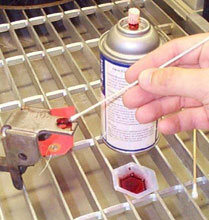Common Uses of Liquid Penetrant Inspection
 Liquid penetrant inspection (LPI) is one of the most widely used nondestructive evaluation (NDE) methods. Its popularity can be attributed to two main factors: its relative ease of use and its flexibility. LPI can be used to inspect almost any material provided that its surface is not extremely rough or porous. Materials that are commonly inspected using LPI include the following:
Liquid penetrant inspection (LPI) is one of the most widely used nondestructive evaluation (NDE) methods. Its popularity can be attributed to two main factors: its relative ease of use and its flexibility. LPI can be used to inspect almost any material provided that its surface is not extremely rough or porous. Materials that are commonly inspected using LPI include the following:
- Metals (aluminum, copper, steel, titanium, etc.)
- Glass
- Many ceramic materials
- Rubber
- Plastics
LPI offers flexibility in performing inspections because it can be applied in a large variety of applications ranging from automotive spark plugs to critical aircraft components. Penetrant materials can be applied with a spray can or a cotton swab to inspect for flaws known to occur in a specific area or it can be applied by dipping or spraying to quickly inspect large areas. In the image above, visible dye penetrant is being locally applied to a highly loaded connecting point to check for fatigue cracking.
 Penetrant inspection systems have been developed to inspect some very large components. In the image shown right, DC-10 banjo fittings are being moved into a penetrant inspection system at what used to be the Douglas Aircraft Company's Long Beach, California facility. These large machined aluminum forgings are used to support the number two engine in the tail of a DC-10 aircraft.
Penetrant inspection systems have been developed to inspect some very large components. In the image shown right, DC-10 banjo fittings are being moved into a penetrant inspection system at what used to be the Douglas Aircraft Company's Long Beach, California facility. These large machined aluminum forgings are used to support the number two engine in the tail of a DC-10 aircraft.
Liquid penetrant inspection can only be used to inspect for flaws that break the surface of the sample. Some of these flaws are listed below:
- Fatigue cracks
- Quench cracks
- Grinding cracks
- Overload and impact fractures
- Porosity
- Laps
- Seams
- Pin holes in welds
- Lack of fusion or braising along the edge of the bond line
As mentioned above, one of the major limitations of a penetrant inspection is that flaws must be open to the surface. To learn more about the advantages and disadvantages of LPI, proceed to the next page.